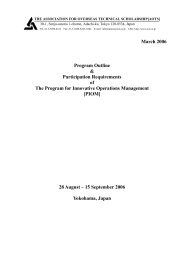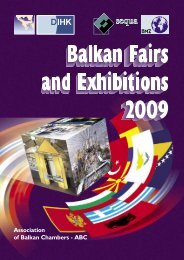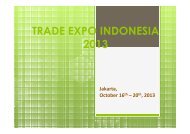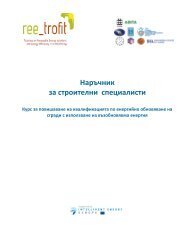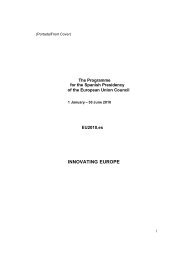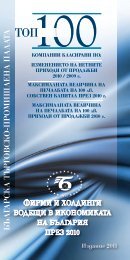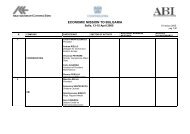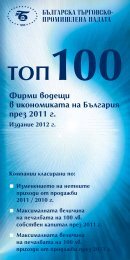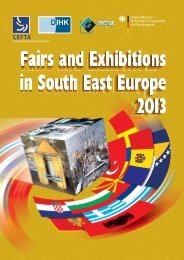Analysis of the Operation and Financial Condition of the Enterprise
Analysis of the Operation and Financial Condition of the Enterprise
Analysis of the Operation and Financial Condition of the Enterprise
Create successful ePaper yourself
Turn your PDF publications into a flip-book with our unique Google optimized e-Paper software.
<strong>Analysis</strong> <strong>of</strong> <strong>the</strong> <strong>Operation</strong> <strong>and</strong> <strong>Financial</strong> <strong>Condition</strong> <strong>of</strong> <strong>the</strong> <strong>Enterprise</strong>capitalBy analysing Table 5.4 it can be found that <strong>the</strong> amount <strong>of</strong> current assets <strong>of</strong> <strong>the</strong>enterprise is too small to sustain a sufficient working capital. According to <strong>the</strong> most recentdata fur<strong>the</strong>r 75 thous. CU would be required for <strong>the</strong> working capital <strong>of</strong> <strong>the</strong> enterprise to besufficient. Besides, by looking at <strong>the</strong> dynamics <strong>of</strong> <strong>the</strong> working capital one can project that<strong>the</strong> enterprise could be short for <strong>the</strong> 2X10 summer period even with <strong>the</strong> 75 thous. CU.Ano<strong>the</strong>r solution for increasing <strong>of</strong> <strong>the</strong> working capital would be a more efficient use <strong>of</strong> <strong>the</strong>existing current assets. The possibilities for a more efficient use <strong>of</strong> <strong>the</strong> current assets at <strong>the</strong>disposal <strong>of</strong> <strong>the</strong> enterprise will be looked at in fur<strong>the</strong>r sections under <strong>the</strong> topic <strong>of</strong> currentasset management in <strong>the</strong> enterprise.5.3. Activity ratio analysis <strong>of</strong> <strong>Enterprise</strong> NCurrent asset turnover ratioFor <strong>the</strong> estimation <strong>of</strong> this value <strong>the</strong> current asset turnover ratio formula 4.13 is used.In order to estimate <strong>the</strong> current asset turnover ratio, it is necessary to know <strong>the</strong> net turnoverfigure for <strong>the</strong> enterprise toge<strong>the</strong>r with <strong>the</strong> average amount <strong>of</strong> current assets for <strong>the</strong> periodunder consideration.The average amount <strong>of</strong> current assets is arrived at by adding <strong>the</strong> period opening<strong>and</strong> <strong>the</strong> closing value <strong>of</strong> current assets <strong>and</strong> dividing <strong>the</strong> amount by two. As it is impossibleto obtain data on <strong>the</strong> average value <strong>of</strong> current assts as <strong>of</strong> 31/12/2XX7, <strong>the</strong> current assetturnover ratio for this period end will not be estimated. Noting that <strong>the</strong> period underconsideration is a quarter, but not a year, <strong>the</strong> algorithm for calculation <strong>of</strong> <strong>the</strong> current assetturnover ratio must be corrected a little bit, because <strong>the</strong> total value <strong>of</strong> net turnover increaseseach quarter, while <strong>the</strong> amount <strong>of</strong> current assets does not have <strong>the</strong> trend <strong>of</strong> going up eachquarter by <strong>the</strong> amount <strong>of</strong> increase in each preceding quarter on average. Therefore, in orderto estimate <strong>the</strong> current asset turnover ratio for <strong>the</strong> first quarter, i.e., as <strong>of</strong> <strong>the</strong> end <strong>of</strong> March,<strong>the</strong> net turnover amount has to be multiplied by 4. In order to arrive at <strong>the</strong> value <strong>of</strong> thisratio at <strong>the</strong> end <strong>of</strong> June, net turnover has to be multiplied by 2, <strong>and</strong> in order to calculate <strong>the</strong>same ratio at <strong>the</strong> end <strong>of</strong> September, <strong>the</strong> net turnover amount has to be divided by 3 <strong>and</strong>multiplied by 4. However, to make <strong>the</strong> same estimate as <strong>of</strong> <strong>the</strong> end year, no adjustment hasto be made to net turnover.By looking at Table 5.5 ‘Estimate <strong>of</strong> <strong>the</strong> current asset turnover ratio for <strong>the</strong> periodfrom 31/03/2XX8 to 31/12/2XX9 in <strong>Enterprise</strong> N’ it can be noticed that within one year onaverage <strong>the</strong> current assets are turned over at least 3 times. There is an exception in <strong>the</strong>period from <strong>the</strong> beginning <strong>of</strong> 2XX9 until <strong>the</strong> middle <strong>of</strong> 2XX9 when <strong>the</strong> current assetturnover ratio was below 2.5. The improvement in <strong>the</strong> current asset turnover ratio during<strong>the</strong> two last quarters <strong>of</strong> 2XX9 is not due to an increase in <strong>the</strong> net turnover figure, but ra<strong>the</strong>rdue to a decrease in current assets that may not be positively evaluated as <strong>the</strong>re is a needfor additional working capital for enhancement <strong>of</strong> <strong>the</strong> enterprise liquidity.5.5.Table96



